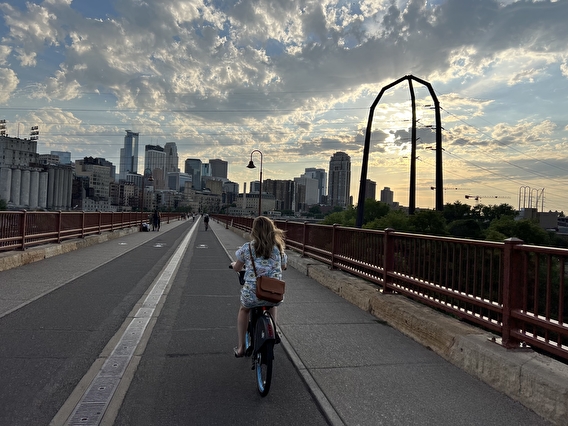
Shared mobility has the potential to meet many of Minnesota’s transportation goals, but according to a U of M research team, current systems are a patchwork of public and private entities loosely partnering with one another, often with differing or even conflicting aims.
Shared mobility—which includes modes such as ride-hailing services, carshare programs, and rental bikes or scooters—can reduce car reliance, congestion, and emissions. It provides transportation options for people who cannot drive or afford a car, and it can contribute to MnDOT’s greater goal of creating a greener, more equitable, and multimodal transportation system across the state.
“As these services grow, cities have had micromobility and ride-hail services appear on their streets overnight with little advanced planning from the companies, causing cities to rush ad hoc operational decisions,” says Katherine Henly, a recent graduate of the Humphrey School of Public Affairs.
As part of a summer capstone course, Henly and fellow Humphrey School grad students Kari Irber and Erica Orcholski set out to better understand these public-private partnerships and create recommendations and guidelines for better integrating shared mobility into Minnesota’s transportation systems. Their project was supervised by Robin Phinney (adjunct faculty member in the Humphrey School) and completed in collaboration with MnDOT’s Office of Transit and Active Transportation Program as part of a 2022–2023 Resilient Communities Project (RCP) partnership.

RCP is a program at the U’s Center for Urban and Regional Affairs that connects faculty and students with local government agencies in Minnesota to address strategic projects that advance local resilience, equity, and sustainability.
During summer 2022, the students interviewed public shared mobility practitioners and private service providers in Minnesota and researched case studies from around the country. The team found that municipalities often see shared mobility as a means of reaching equity and environmental goals, partnering with private companies to put systems in place. However, this strategy may come with built-in tension—public agencies serve the public, while private companies need to make a profit.
The students noted, for example, that the piecemeal nature of shared mobility has led to gaps—areas with no service options. The “last-mile gap” (often between transit stops and private residences) is the biggest example.
Generally, private companies have no incentive to fill these gaps in low-income communities, even though lower-income neighborhoods often possess the necessary elements (high density and walkability) and need shared mobility the most.
“Two cities pointed out that the shared mobility companies often do not place bikes or scooters in low-income areas, even when specified in their contract,” the final report says.
Urban-fringe municipalities also tend to have trouble negotiating shared mobility contracts because they lack the population density to make them attractive to private companies.
To address these issues, the students made recommendations around contracts, coordination, and communication:
Municipal officials need information about the different types of contracts between public and private entities. The students documented the pros and cons of some of the more commonly used contract types; they generally found that municipalities have more negotiating leverage when they enter into agreements well-informed.
“Knowing and understanding the various models can help shared mobility leads make those informed decisions on what model is best for their community,” the report states.
Useful third-party resources are available for shared mobility research, such as the Shared Use Mobility Center’s Micromobility Policy Atlas. Many municipalities also expressed in interviews that they would like a more centralized repository of information on shared mobility—something the students think MnDOT is in a position to create.
The possibility of a regionalized mobility system in the Twin Cities and across Minnesota should be explored. It would take pressure off individual municipalities and save on resources by standardizing how shared mobility operates and by preventing conflict between neighboring municipalities.
The students propose that the Metropolitan Council specifically would be in a good position to take the lead on planning the system, with MnDOT coordinating work across the state.
Local governments need to be fully on board with shared mobility. The students noted that wealthy white communities will often sway local governments away from funding shared mobility because it is perceived as catering to BIPOC communities.
“Without buy-in from elected leadership,” the report warns, “the shared mobility agreement process will most likely fail.”
- Municipalities need to be more generally connected with one another. The students recommend leveraging and promoting existing resources such as the Minnesota Shared Mobility Collaborative (SMC). Individuals can apply to join the SMC steering committee or participate in its quarterly public convenings.
“The work these student researchers did in partnership with RCP was an important first step in documenting the shared mobility landscape in Minnesota and understanding the needs of both public- and private-sector players,” said Elliott McFadden, MnDOT’s Greater Minnesota Shared Mobility Coordinator and the MnDOT lead on this project. “Their report and related research will be the basis of building a P3 toolbox at MnDOT as a resource for communities wanting to introduce or expand shared mobility options.”
Further research, the students say, should put greater emphasis on community involvement, examine a wider variety of public-private contract types, and include rural transportation perspectives. Read more in the students’ final report: Exploring Shared Mobility Public-Private Partnerships.
Writer: Sophie Koch


